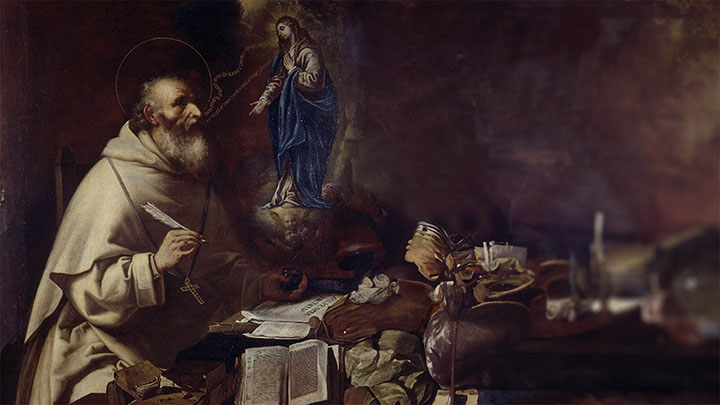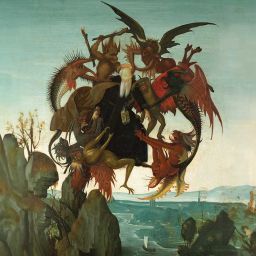
Thematic Issue (Illuminating Life)
by Fr. Neil J. Roy, STL, PhD; Chaplain & Director, Inspiring Faith*
*Saint Albert the Great Institute for Science, Faith & Wisdom
Saint Albert the Great: Scientist, Theologian & Philosopher
Words of Wisdom: "I shall not conceal a science that was before me revealed by the grace of God; I shall not keep it to myself, for being afraid of attracting its curse. What worth is a concealed science; what worth is a hidden treasure? The science I have learned without fiction I transmit with no regret." St Albert the Great, The Compound of Compounds [a work on alchemy]
DOCTOR OF THE CHURCH
Every Catholic center of learning, however humble, ought to take care to acknowledge the inestimable contributions of those saints who are distinguished by the illustrious title of doctor of the Church. Currently the Church recognizes 37 saints as doctors or teachers of the Church.
The doctors of the Church remind us that God can be known, even if only in a limited, indeed imperfect way, by the human mind. St Albert the Great, a member of the Order of Preachers, demonstrated, throughout his highly productive apostolate as a scholar and teacher, that God can be known not only through philosophy and theology, but also through the natural sciences. God, after all, is the Creator and Ruler of all things. St Augustine reminds us that every creature therefore bears the traces or “fingerprints” of the Triune God who brought it into being.
A DOMINICAN FRIAR, SCHOLAR, PROFESSOR AND BISHOP
Today natural scientists, researchers, and indeed all lovers of truth, invoke their patron saint. Albert, now known as “the Great,” was a Dominican friar, scholar, professor, and bishop whose life spanned most of the “golden” thirteenth century (1206-1280). As a teacher and mentor of the illustrious St Thomas Aquinas, St Albert was the first to recognize the exceptional brilliance of his fellow Dominican friar. Accordingly, Albert warmly recommended Thomas to the attention of his superiors, thereby advancing the academic career of that towering theological and philosophical mind. thought and mind of man strengthening the power of vision.”
Albert, like his prize student Thomas, enjoyed high social advantages owing to the noble status of his family. He was the eldest son of the count of Bollstädt, a Bavarian title. In fact, Albert was born in the family castle at Lauingen on the Danube, in the duchy of Swabia, southwest Bavaria, Germany.
From his early youth, Albert cultivated an ardent devotion to the Blessed Virgin Mary. Albert shocked his family, however, when he announced his plan to join the Dominicans. The Order of Preachers had received official approbation from the papacy only a decade after Albert’s birth, and its friars collected alms through mendicancy. Albert’s aristocratic family could scarcely contemplate their beloved Albert joining a band of begging friars.
Nevertheless, Albert persevered in his Dominican vocation, and eventually distinguished himself as one of the foremost theologians of his day. Today this holy polymath is acclaimed as the “Universal Doctor.” Albert exercised his teaching apostolate in a wide variety of places: Cologne, Hildesheim, Freiburg im Breisgau, Regensburg, Strasbourg, Paris, and Rome. He even served for a brief period, in the mid-1250s, as personal theologian to the pope. Albert was appointed bishop of Regensburg in 1260 but resigned his see two years later in order to devote himself full time to his teaching and research.
MENTOR AND LIFETIME FRIEND OF SAINT THOMAS AQUINAS
One of the great joys of Albert’s teaching career was his discovery of the extraordinary Thomas Aquinas, whom he delighted to teach for four years. An inferior character would have been envious of the great prodigy, and perhaps might even have felt threatened by Thomas’ formidable intellect and vast knowledge. Instead, in the tradition of the best educators, Albert did everything he could, in and outside the lecture hall, to foster Thomas’ intellectual formation. Albert welcomed the younger Thomas as a colleague and as a friend. Their friendship ended with the death of St Thomas in 1274.
Patron Saint of Sciences and Many Written Works About the Natural Sciences, Logic, Metaphysics, Theology, and Sacred Scripture
Albert himself played a prominent role at the Second Council of Lyons in 1274. He died at Cologne on 15 November 1280 after suffering a loss of memory and a subsequent steep decline in health. Some today speculate that he suffered from a form of dementia not unlike Alzheimer’s disease.
By the time of his death, Albert the Great had published 38 books on topics that included biology, botany, human and animal physiology, mathematics, physics, chemistry, alchemy, mineralogy, geography, and astronomy, as well as logic, metaphysics, theology, and sacred Scripture.
Albert brought to his study of theology a great love of the natural sciences; hence after Pope Pius XI canonized him and declared him a doctor of the Church in 1931, his successor, Ven. Pius XII made St Albert the heavenly patron of the natural sciences. Owing to his astounding array of interests and expertise he now enjoys the epithet of “universal doctor.”
The Hand of God in All Wonders of Nature and Inspiring Faith of Scientists
It is good for us to see, as Albert so eminently did, the hand of God in all the wonders of nature, for it was the hand of God which formed all things and brought them into being. For Christians there is no quarrel or conflict between faith and science. Contrary to the positions of skeptics and fideists alike, faith and reason are not mutually exclusive. Indeed, truth itself is the aim and the governing principle of both faith and reason.
The Church prays that scientists may see the hand of God at work in the creation which, in His mystery, He has summoned into existence. The more diligent the scientist, the more attentive he or she must be to the overwhelming mystery of all that God has called into being. Divine mysteries certainly excel our understanding, but they do not contradict it. We therefore should apply ourselves with diligence and zeal to all the branches of learning available to us. If we are attentive to what our eyes see and our ears hear, we may well discover more profoundly the God who sustains everything in being and who wants us to come to the knowledge of Him and to be drawn into His eternal love.
The Logo of Wisdom that Reflects Virtue, Truth, and Torchbearer for All
The logo of the St Albert the Great Institute features a half-length portrait of St Albert framed by a hexagonal prism, rather like a window. The hexagonal window suggests the cell within the comb of a honeybee, a creature known for its industry and associated with perennial wisdom. Both virtues aptly reflect the character of Albert the Great. Emerging from this symbolic window, the saint wears the white tunic and black cloak of the Dominican habit and is crowned with the miter of a bishop. With the quill in his right hand he transmits his thoughts in a book, emblematic of his scholarship, while his left hand holds aloft a torch of truth, in the light of which Albert carried out his research. Not only does the saint use the torch for his own purposes; he extends it for the benefit likewise of the viewer. This gesture exemplifies the motto of the Dominicans: Contemplare et contemplata aliis tradere [to contemplate and to hand on to others the fruits of contemplation].
The torch alludes to a wondrous vision closely associated with the origins of the Dominican Order. In sacred iconography, St Dominic Guzman (1170 to 1221), the founder of the Order of Preachers, is frequently depicted with the hagiographical attribute of a dog bearing a torch in its mouth. Sometime before Dominic’s birth, his mother, Bd Juana of Asa, had a dream in which she gave birth to a dog which ran through the world with a flaming torch in its mouth. Disturbed by this dream, Juana sought guidance from the abbot of the monastery of St Dominic of Silos. The abbot interpreted Juana’s dream as a message that the child that she was to bear would bring the light of the Christian gospel throughout the earth. The Order of Preachers came to be nicknamed “the hounds of the Lord” [Domini canes], who, like untiring sheep dogs, would protect the Lord’s flock from error and enemies of the Faith.
St Albert the Great, in his day, took up the torch of Truth [Veritas, another Dominican motto], entrusted to him by his ecclesiastical superiors. Lovers of the Truth can themselves participate in the apostolate of the St Albert the Great by bearing the torch of Truth in their respective missions, projects, and endeavors. Living in and by the Truth ennobles every human enterprise. Moreover grace, which is a sharing in the divine life, elevates each work to the level of the supernatural.
Under St Albert the Great’s influence, torchbearers can themselves grow in wisdom, knowledge, and holiness while sharing the light of Truth with colleagues, partners, and students. Albert’s example of industry, fidelity, and sanctity may inspire creativity and joy in the investigation of Truth in a variety of areas, while his heavenly intercession may fortify us in persevering in the path of virtue and ethical responsibility.







